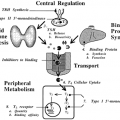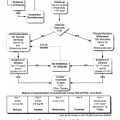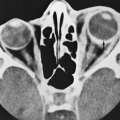REPRESSION OF BASAL TRANSCRIPTION/COREPRESSORS
Unliganded TRs bind to TREs and can repress transcription of positively regulated target genes (Fig. 31-5). Although the physiologic significance of this basal repression is not known, it may influence target-gene expression during early fetal development when the fetal thyroid gland is incapable of producing TH. The basal repression may be due, in part, to interactions with the basal transcription machinery as unliganded TRs can interact with transcription factor IIB (TFIIB), a key component of the basal transcription complex.19 However, several laboratories have cloned proteins that interact with TR and retinoic acid receptor (RAR) in the absence of their cognate ligands.11,12 These proteins repressed basal transcription by TR and RAR and have been termed corepressors. One of these corepressors is a 270-kDa protein termed nuclear-receptor corepressor (N-CoR). It has two transferable repression domains and a carboxy-terminal α-helical interaction domain. A truncated version of N-CoR, N-CoRi, which is missing the repressor region, also has been identified and may represent an alternative-splice variant of N-CoR.20 This protein blocks basal repression by N-CoR and thus may serve as a natural antagonist for N-CoR. Another corepressor, silencing mediator for RAR and TR (SMRT), is a 168-kDa protein that has some homology with N-CoR.11,12
Stay updated, free articles. Join our Telegram channel

Full access? Get Clinical Tree







